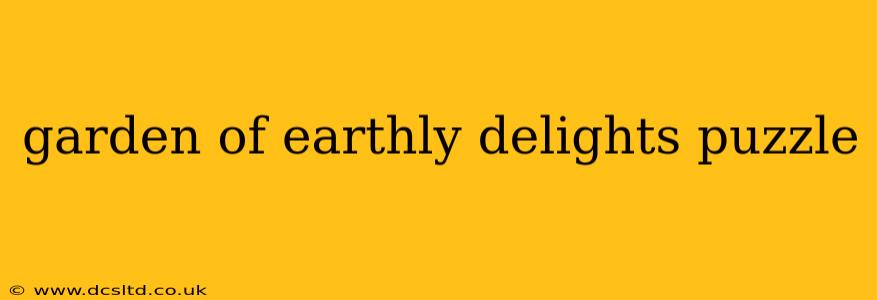Hieronymus Bosch's Garden of Earthly Delights triptych isn't just a painting; it's a visual riddle, a fantastical landscape teeming with symbolism that has captivated and confounded art historians and enthusiasts for centuries. Its intricate details and enigmatic imagery make it a perfect subject for analysis and interpretation, and even inspire puzzle-making. This post delves into the mysteries of the painting, exploring its common interpretations and addressing some frequently asked questions.
What is the Garden of Earthly Delights about?
This is the million-dollar question! There's no single, universally accepted answer. The painting's meaning is open to interpretation, and various theories exist. The prevailing view suggests the triptych depicts the progression of humanity: from the creation of Adam and Eve in the left panel, to the indulgence and decadence of earthly life in the central panel, and finally, the hellish consequences in the right panel. However, the symbolism is layered and complex, with many elements still debated. The interpretation often depends on the viewer's perspective and understanding of religious and philosophical contexts of Bosch's time.
What are the main symbols in the Garden of Earthly Delights?
The painting is overflowing with symbolic imagery. Some key symbols include:
- Fruit and Plants: Representing both the pleasures and temptations of earthly life, but also potentially possessing hidden alchemical or religious meanings.
- Strange Creatures: Hybrid animals and fantastical beings reflect the unpredictable and often chaotic nature of human experience and potentially symbolize sin or temptation.
- Musical Instruments: Suggesting celebration and revelry, but also hinting at the ephemeral nature of earthly pleasures.
- Architectural Structures: Often interpreted as representing the social and political structures of Bosch's time, as well as potentially having symbolic connections to the human body.
- Water and Light: Symbolic of both purity and the dangers of temptation. The light in the central panel, for example, suggests both joy and potential corruption.
What is the significance of the central panel?
The central panel is undoubtedly the most captivating and perplexing. It depicts a vibrant, lush garden overflowing with human figures engaged in a variety of activities, many of them sensual and suggestive. This is generally interpreted as a representation of the earthly delights – the pleasures and temptations that humans readily succumb to. However, the chaotic and often bizarre nature of the depictions suggests a warning against unchecked indulgence and the potential consequences of straying from divine grace. The ambiguity is intentional, provoking viewers to ponder the meaning of earthly pleasures and their potential repercussions.
What does the right panel of the Garden of Earthly Delights represent?
The right panel stands in stark contrast to the central panel, depicting a hellish landscape filled with grotesque figures, tormented souls, and bizarre punishments. This panel is generally interpreted as a representation of the consequences of the sins and excesses depicted in the central panel. It's a terrifying vision of divine judgment and the fate awaiting those who succumb to temptation and abandon their faith. The horrific imagery serves as a stark warning against moral decay and the importance of adhering to religious principles.
Is the Garden of Earthly Delights a religious painting?
While the painting's religious elements are undeniable, its interpretation isn't straightforwardly religious. It's more accurate to say that it engages with religious themes through a highly symbolic and often ambiguous lens. Bosch blends religious iconography with elements of folklore, alchemy, and possibly even satire, leading to interpretations that are both deeply theological and critically insightful about human nature. The painting's complexity transcends simple religious allegory, engaging with broader themes of morality, temptation, and the consequences of human choices.
What puzzles exist surrounding the Garden of Earthly Delights?
Many puzzles remain about The Garden of Earthly Delights. These include the precise identification of many of the symbols, the intended moral message, and the extent to which Bosch's personal experiences and beliefs shaped the work. The painting's enigmatic nature encourages ongoing scholarly debate and diverse interpretations, ensuring its enduring fascination for centuries to come. For example, the identity of specific figures, the meaning of peculiar objects, and the overall narrative arc remain open to interpretation and fuel ongoing research and discussion. The very act of trying to “solve” the painting's puzzle is a testament to its power and lasting relevance.
By exploring these questions and interpretations, we can appreciate the layers of complexity and the enduring mystery that make The Garden of Earthly Delights a masterpiece not only of art, but of intellectual and spiritual engagement.
